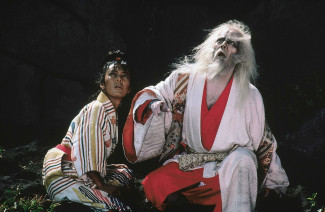REVIEW: ‘A.K.’ provides behind-the-scenes portrait of Kurosawa on set

For fans of Akira Kurosawa’s career, A.K., the 1985 documentary detailing the legendary director’s work on Ran, is a must-see film. These 72 minutes capture one of the most iconic directors to ever work in the medium from an intimate, behind-the-scenes view. The resulting portrait is one of brilliance, leadership, respect and fortitude. Kurosawa, even late in his career, worked tireless hours to capture cinematic shots on a grand scale.
Ran, which will soon play the Film Forum in New York City, is an epic war film based on a common parable about a father who struggles to divide his fortunes among his three sons. The inheritance question is the cause of several large battle sequences, which are difficult to film but also the preferred scenes for Kurosawa to show his skill.
A.K., which finishes its one-week run at the Film Forum Thursday, Feb. 25, is divided among several themes that have influenced the director’s work. Viewers will see how fire, fog and rain, among other elements, affect the arduous storytelling process. Plot points and characters are meticulously detailed because Kurosawa is a perfectionist, someone who will wait, wait, wait for the requisite weather to start filming.
Throughout the documentary, the director comes off as a revered leader on set. He’s dropped off by a car at 10 a.m. and works long hours. When he says a command, it definitely is followed; however, his leadership comes from an artistic reverence rather than a totalitarian one. Yes, he has demands and desires that seem almost impossible to pull off, but through his focused vision, the film comes together into a masterpiece. There’s no denying that Kurosawa — still to this day — is considered one of the most successful directors of all time because of his consistency of vision and style across decades in the medium. This behind-the-scenes portrait of Ran is merely one example of his dedication on display.
Chris Marker directed A.K. with a lot of access on the set of Ran; however, he also keeps a distance. There are no sit-down interviews with Kurosawa or his crew. Instead, Marker’s cameras follow everyone as they perform their many tasks and face numerous challenges. A thoughtful, sometimes poetic voiceover fills in the blanks and adds some context. Because there’s no in-depth conversation with the maestro himself, the documentary has a voyeuristic feel, which works to its advantage and disadvantage. It does feel like A.K. is documenting reality rather than changing it, but, at the same time, the film feels faraway, with only a cursory understanding of what makes Kurosawa tick.
The audience members most interested in A.K. will be cinephiles and those who plan to enjoy the new 4K restoration of Ran. It’s almost required viewing to check out the documentary and then sit through Kurosawa’s epic to see how the director finally pulled off his vision.
By John Soltes / Publisher / John@HollywoodSoapbox.com
- A.K.
- 1985
- In French and Japanese with English subtitles
- Directed by Chris Marker
- Featuring Akira Kurosawa
- Running time: 72 minutes
- Rating:





